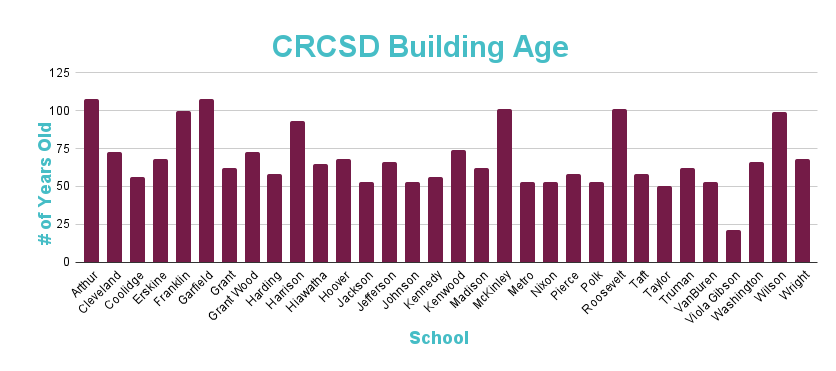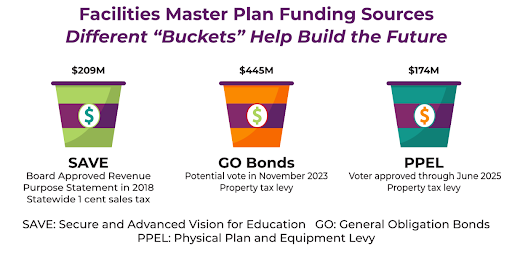
Our kids deserve the best! Together, we can make a meaningful impact and build a brighter future for our students.
Cedar Rapids Community School District, or CSCSD as we commonly refer to ourselves, has a rich history of educating students since 1855. We are Iowa’s second-largest public school district, with more than 16,000 students and nearly 3,100 employees.
Comprehensive Facilities Master Plan
The district’s new 14-year Comprehensive Facilities Master Plan is a fiscally responsible plan that reimagines our school facilities to help address current realities and future demands. It would make improvements district-wide to address needed infrastructure upgrades and provide modern, safe learning environments. The plan will also consolidate the district’s school facilities, create a feeder school system, and add career and technical education (CTE) opportunities in three of our high schools. By 2037, ALL students would be in a new or recently renovated building.
The district has already been strategically addressing the needs at the elementary school level by using local option sale tax dollars. The next step is to focus on the district’s middle school and high schools. The plan for addressing the secondary schools has been broken up into two phases that would draw funding from several sources, including a proposed General Obligation (GO) Bond. Phase 1 of the plan would include a GO Bond for $220 million, which would go up for community vote on November 7, 2023.
You can learn more about the projects included in each phase of the Comprehensive Facilities Master Plan by clicking on the links below.
History
History of the Facility Master Plan:
Cedar Rapids Community School District had originally developed a 20-year Facility Master Plan back in 2016. This plan was guided by recommendations from a Facility Master Planning (FMP) Committee, community feedback, and input from our staff and Board of Directors. The plan focused on providing modern, safe, and equitable facilities for our staff, students, families, and communities. In 2018, the Board approved to proceed with the elementary phase of that plan. This has included the construction of West Willow, Maple Grove, and Trailside Elementary Schools. However, due to several district leadership changes since 2018, the rest of the Facilities Master Plan was paused. In the meantime, the district paid off all GO Bond Dept and re-convened the Community Facilities Task Force. A new, updated Facilities Master Plan was then made and released in 2023.

History of District Buildings:
Cedar Rapids Community School District currently has 32 school buildings. The average age of these buildings is 68.5 years. In fact, 75% of the district’s buildings used today were built before 1970, and 5 buildings are 100+ years old. Meaning our students are being taught in classrooms that were designed and built for their grandparents and great-grandparents.
Our students, curriculum, technology, and accessibility requirements have changed significantly over the decades. The older compartmentalized designs don’t support today’s need for open, flexible, and collaborative learning spaces. Our class offerings continue to grow, which require classrooms and support spaces. Teaching practices and classroom technology requirements have also changed drastically over the years. And we are sure to see even more changes and advancements in the next 50 years.
As the buildings continue to age, the cost of upkeep and repairs will continue to rise. The district’s annual operating budget only covers essential maintenance and repairs. If major repairs or improvements are needed, the operating budget could not cover it, which could significantly impact our staff and students. Also, construction costs continue to rise, outpacing inflation.

Funding
As our buildings continue to age, the cost of upkeep and repairs will continue to rise. The district’s annual operating budget currently only has money to cover basic maintenance and repairs. Building improvements on this scale cannot be covered under the district’s yearly general operating budget without significantly impacting staff and students. That is where a bond comes into play. Bonds allow the district to cover the cost of major renovations, repairs, and upgrades that otherwise could not be done due to the annual operating budget. This is the standard practice statewide.
This new comprehensive Facilities Master Plan would draw funding from several sources, including SAVE, PPEL, and 2 proposed General Obligation (GO) Bonds. Phase 1 of the plan would include a GO Bond for $220 million, which would go up for community vote on November 7, 2023. Phase 2 of the plan will include a GO Bond for $225 million, which will go up for a community vote in 2029.

